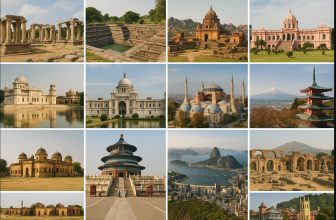The Indian National Army (INA) was one of the most remarkable forces in India’s fight for independence. Unlike the non-violent movements led by Mahatma Gandhi and the Congress, the INA, under Subhas Chandra Bose’s leadership, took a military approach to overthrow British rule.
Formed with the support of Japan and Germany during World War II, the INA aimed to liberate India through armed resistance. It played a key role in the Burma Campaign, inspired the Royal Indian Navy Mutiny, and ignited mass protests across India, pushing the British closer to leaving.
From hoisting the first Indian flag in Manipur to establishing an all-women combat regiment, the INA’s contributions remain one of the most powerful yet underappreciated chapters of India’s independence movement. Here are key contributions of the INA that shaped India’s freedom struggle.
1. Formation of the Indian National Army (INA)
- Origins: The INA was initially formed in 1942 by Captain Mohan Singh, a British Indian Army officer who was captured by the Imperial Japanese Army during World War II. He saw an opportunity to mobilize Indian prisoners of war (POWs) to fight against British rule.
- Indian Independence League (IIL): The INA was supported by the Indian Independence League (IIL), a nationalist organization in Southeast Asia, led by Rash Behari Bose.
- Dissolution and Revival: Due to disagreements with the Japanese, Mohan Singh disbanded the INA. However, in 1943, Subhas Chandra Bose revived and reorganized it, renaming it the Azad Hind Fauj (Free Indian Army).
2. Leadership of the INA – Subhas Chandra Bose’s Role
- Subhas Chandra Bose’s Arrival: Bose, who had escaped British custody in 1941, traveled from Germany to Japan via submarines to take charge of the INA in July 1943.
- Provisional Government of Free India: He established the Provisional Government of Free India (Arzi Hukumat-e-Azad Hind) on October 21, 1943, in Singapore, with the INA as its military wing.
- War Cry & Mobilization: Bose gave the famous slogan “Dilli Chalo” (March to Delhi) and expanded the INA’s recruitment to include civilians and ex-British Indian Army soldiers in Southeast Asia.
3. INA’s Role in the Burma Campaign (1944-45)
- Military Alliance with Japan: The INA, alongside the Japanese Imperial Army, launched an attack on British-occupied India through Burma (Myanmar) in early 1944.
- Key Battles:
- Battle of Imphal (March–July 1944) – The INA advanced toward Imphal, but logistical issues and Allied air superiority led to a major setback.
- Battle of Kohima (April–June 1944) – The INA and Japanese forces engaged in a fierce battle against British and Indian troops.
- Liberation of Moirang: The INA successfully captured Moirang in Manipur in April 1944, where they hoisted the Indian tricolor flag, marking the first liberated Indian territory.
4. Women’s Participation – The Rani of Jhansi Regiment
- Formation: The INA established the Rani of Jhansi Regiment, one of the world’s first all-women combat units, led by Captain Lakshmi Sahgal.
- Combat Training: The regiment trained Indian women from Southeast Asia in warfare, intelligence, and medical assistance.
- Role in the INA: While they were ready for battle, the INA’s defeat meant they were never fully deployed in combat.
5. INA’s Military Structure and Strength
- Size: The INA had around 60,000 soldiers at its peak, making it one of the largest armed resistance forces in India’s independence struggle.
- Brigade Leaders:
- Shah Nawaz Khan
- Gurbaksh Singh Dhillon
- Prem Kumar Sehgal
- Combat Units: The INA was divided into brigades, with divisions specializing in artillery, intelligence, and logistics.
6. INA’s Alliance with Axis Powers (Japan and Germany)
- Strategic Partnerships: To challenge British supremacy, the INA allied with Axis powers, receiving military training, financial support, and equipment from Japan and, to a lesser extent, Germany.
- Territorial Administration: Japan ceded control of the Andaman and Nicobar Islands to the Provisional Government of Free India, symbolizing a transfer of authority. These islands were renamed Shaheed (Martyr) and Swaraj (Self-Rule), respectively.
- Ideological Alignment: While the INA’s collaboration with Axis powers was primarily strategic, it sparked debates about the ethical implications of aligning with imperialist regimes. Bose’s stance was driven by the belief that the enemy of his enemy could be a friend in the struggle for India’s liberation.
7. The Fall of the INA and Its Surrender (1945)
- Retreat from Burma: After Japan’s defeat in the Battle of Imphal (1944), the INA was forced to retreat.
- Japanese Surrender: In August 1945, following the atomic bombings of Hiroshima and Nagasaki, Japan surrendered, cutting off the INA’s support.
- Bose’s Mysterious Death: Bose allegedly died in a plane crash in Taiwan on August 18, 1945, though this remains a subject of debate.
8. INA Trials and Public Outrage in India (1945-46)
- Red Fort Trials: The British colonial government initiated court-martial proceedings against INA officers, notably Shah Nawaz Khan, Gurbaksh Singh Dhillon, and Prem Kumar Sahgal, charging them with treason, murder, and torture. These trials were held at the historic Red Fort in Delhi.
- Nationwide Protests: The trials ignited widespread public outrage across India. People from diverse communities and political backgrounds united in protest, viewing the INA soldiers as patriots rather than traitors.
- Political Pressure: The mass protests and the potential for civil unrest pressured the British authorities to commute the sentences of the accused INA officers, reflecting the shifting political landscape in India.
9. The Role of INA in Triggering Naval Mutiny (1946)
- Inspiration for Rebellion: The bravery and sacrifices of the INA inspired discontent within the Royal Indian Navy (RIN). Sailors, motivated by the INA’s actions and grievances over their own service conditions, initiated a mutiny in February 1946.
- Scope of the Mutiny: The RIN mutiny began in Bombay (now Mumbai) and rapidly spread to other ports, involving approximately 10,000 sailors across 78 ships and shore establishments. The mutineers demanded better working conditions and expressed solidarity with the INA.
- Impact on Independence Movement: The mutiny, combined with the INA’s legacy, intensified nationalist sentiments and demonstrated the erosion of loyalty within the British Indian armed forces, hastening the British decision to grant India independence.
10. INA’s Influence on India’s Independence (1947)
- Erosion of Colonial Authority: The INA’s actions, coupled with subsequent military uprisings like the RIN mutiny, showcased the declining control of the British over Indian armed forces.
- Catalyst for Political Change: The collective impact of these events created an environment where British colonial rule became untenable, leading to the decision to transfer power and grant India independence on August 15, 1947.
- Legacy of Unity and Sacrifice: The INA’s diverse composition, cutting across religious and regional lines, set a precedent for unity in the face of colonial oppression, leaving an enduring legacy in India’s post-independence narrative.
11. Legacy of the INA in Modern India
- Symbol of Resistance: The INA is commemorated as a symbol of armed resistance against colonial rule, with its veterans honored for their contributions to India’s freedom.
- Subhas Chandra Bose’s Enduring Influence: Bose’s vision and leadership continue to inspire political discourse and cultural expressions in India, reflecting the enduring impact of his commitment to complete sovereignty.
- Memorials and Museums: Institutions like the Netaji Subhas Chandra Bose Museum at the Red Fort in Delhi serve to educate the public about the INA’s role in the independence movement, preserving its history for future generations.
12. INA Memorials and Recognitions
- International Memorials: The INA War Memorial in Singapore stands as a testament to the sacrifices of INA soldiers, marking the site where Bose first proclaimed the establishment of the Provisional Government of Free India.
- Declassification of Historical Records: Efforts have been made to declassify documents related to the INA and Bose, providing scholars and the public with deeper insights into their contributions and the complexities of their struggle.
- Commemorative Events: Annual events and ceremonies are held to honor the legacy of the INA, ensuring that their contributions to India’s independence are remembered and celebrated.
Final Thoughts
The Indian National Army (INA), led by Subhas Chandra Bose, played a crucial role in India’s fight for freedom. From launching military attacks against British India to inspiring revolts within the Indian armed forces, the INA’s efforts weakened British control and accelerated India’s path to independence.
Although it did not win militarily, its influence was felt across India, leading to the Red Fort Trials, mass protests, and even the Royal Indian Navy Mutiny of 1946. These events shook the British Empire’s confidence, making it clear that India’s independence was inevitable.
The legacy of the INA continues to inspire India’s military and nationalist movements today. Its story is one of courage, sacrifice, and the determination to achieve complete sovereignty.
Source:
- https://reference.nlb.gov.sg/guides/socscihum/history/indian-national-army/
- https://www.britannica.com/topic/Indian-National-Army





